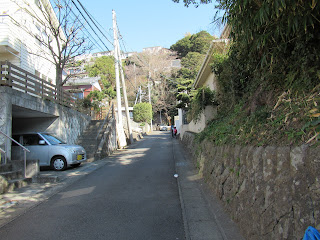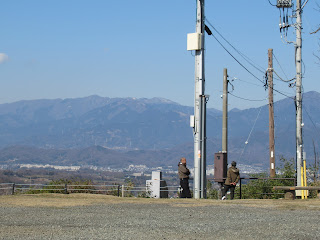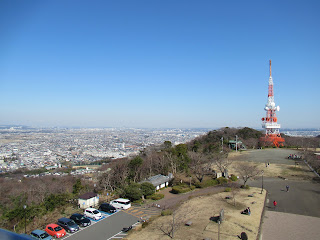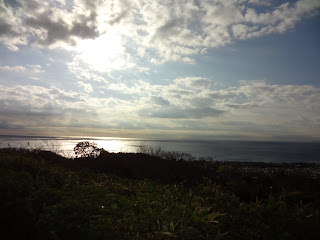Downtown of Oiso 大磯町 is elongated along the coast. Thanks to the crash between Philippines and North American plates, the flat downtown has little chance to be wider, but the Oiso Hill 大磯丘陵 immediately behind the coastal area is still growing taller. The hill itself expands to Shinseiko Lake 震生湖 in Hadano City 秦野市, with several hiking courses. The part of Oiso Hill back of downtown Oiso also has popular trekking roads in the forest, which are family friendly. The place has names; Komayama Park 高麗山公園, aka Shonandaira 湘南平, managed jointly by Oiso Town and the City of Hiratsuka 平塚市. This week and next, let’s visit this part of Oiso Town. The place is of natural forest, not the celebrity world of yesteryears, but it certainly has its history.
Actually, when you ask people of Kanagawa who are not so familiar with hiking, they will tell you Shonandaira is a dating spot with an ample parking space. The area called Shonandaira is a part of Komayama Park, with lots of amenities for tourists, including a restaurant, a shop, view spots, parking lots, and a TV tower. When you drive, you ask your car navigation system to Shonandaira, and you’re all set. Or, you take a Kanachu Bus Hira-35 平35 service (; time table is here) from Bus Stop #3 in the north exit of JR Hiratsuka Station, and go to the terminal stop, Shonandaira. The bus ride is for about 15 minutes. To walk around Komayama Park, this is the easiest way to enter the park as the rest of your itinerary is almost descending only to the beachside area. But if you prefer more active way of visit, starting from JR Oiso Station would be the easiest in terms of the condition of trekking roads. So, I tell you first how to reach to Shonandaira from Oiso Station on foot. (The map of the park is downloadable from here.)
 |
| #3 Bus Stop in front of JR Hiratsuka Station |
 |
| Shonandaira, the terminal stop |
 |
| The parking space at Shonandaira |
From Oiso Station please take a narrow road along JR Tokaido Line to the direction of Odawara 小田原. In 5 or so minutes, on our left is Oiso Elementary and on our right there is an underpass. Please cross the train track by this tunnel and go straight. In 5 or so more minutes, on our right is Myodaiji Temple 妙大寺 where in its cemetery Dr. Jun Matsumoto 松本順, a person who made Oiso a celebrity town, rests in peace (; please see my post last week). Next to the temple there is an ordinary house which was once a residence of Taka’aki Katoh 加藤高明 (the 24th PM of Japan). Let’s turn right here on this corner of former PM house. Soon the road in the residential area goes up a steep hill that is behind the Oiso Station. This is the beginning of hiking course. We can see almost entire expansion of seaside downtown of Oiso. In few minutes we reach to a small park, or garden, called Takada Park 高田公園 surrounded by ordinary houses. From there, we can enjoy the views of Sagami Bay 相模湾, Mt. Hakone 箱根, and Mt. Fuji 富士山. The place has a public toilet. The next toilet spot is Shonandaira so that you can utilize the chance here!
 |
| JR Oiso Station: we go to the left in this photo. |
 |
| Follow this road along the JR Tokaido Line, then, |
 |
| Take the tunnel in front of Oiso Elementary. |
 |
| The other side of the tunnel is like this. |
 |
| Myodaiji Temple |
 |
| This is where Dr. Matsumoto was buried. |
 |
| Please turn right here. |
 |
| Go straight and along the way … |
 |
| meet a zig-zagging steep slope climbing up. |
 |
| Oiso downtown seen from the route |
 |
| Eventually, the road folks into a standard paved way and this pedestrian road. Pedestrian route is the short-cut, and safer without fear of car traffic. |
 |
| Then, in front of us is a park where Tamotsu Takada 高田保, who was a famous cultural commentator and an Oiso resident around 1950, is buried. He loved the view of the ocean from there. |
From the north of Takada Park, there is only one road which is first paved for residents along the way, then turns into a trekking road surrounded by forest. It is a ridge way but the most of it is wide enough for 1st graders walking safely. You may find the vegetation here is a bit different from that of, say, inland Hadano City. The area has lots of Machilus thunbergii, Castanopsis sieboldii, and Japanese camellia (Camellia japonica). They are evergreen broadleaved trees that love warm and humid atmosphere of seaside. When I’ve been there in last winter, bright red camellias dotted deep evergreens here and there. That was a fun. Deciduous oaks are minority. They, like jolcham oak (Quercus serrata), are surrounded by the evergreens, and often infected by Japanese oak wilt so that they are under the treatment of “chopping down” by the municipality. The oaks here are famous home for larva of beautiful zephyrus, Favonius orientalis (East Palearctic species of hairstreak butterfly). If there is no oak, what would happen to them here? Oak wilt in Japan was in the end due to human negligence of forest. Sure, they are large in Komayama Park, with the signs of early coppicing. They were once cared for harvesting fuel logs, and abandoned in the 1960s. We must remember this ...
 |
| The road from Takada
Park is first like this. Please keep on going straight. The detour could make you commit a criminal offence of trespassing into a private property. |
 |
| The trees here are certainly old … |
 |
| We can enjoy the view of Sagami Bay along the route. |
 |
| The road finally becomes
a trekking road, and in last February at the beginning there was this notice asking caution for hikers as the municipality treat the infected oaks by Japanese oak wilt. |
 |
| The map is shown here. |
 |
| The ridge way in February |
 |
| The route has several
crossings, which become one eventually (except for one; please see below). So please take whichever way you like. |
 |
| Poor oaks … |
 |
| Yes. We’re hiking! |
 |
| Eventually, a TV Tower
is found over there. That’s our destination. |
In fact, the forest of Komayama Park has been under the heavy influence of human activities for more than a millennium. We’ll see the first evidence of such human activity along the road from Myodaiji Temple. About 1km from Takada park, we meet a signpost showing a detour to “Yokokuji-yato Tunnel Tomb 楊谷寺谷戸横穴群.” Let’s go to see this archeological graveyard. Oiso Town has more than 1000 such ancient tombs build during the 3rd - 6th centuries. The soil of Oiso Hill is not difficult for digging a hole to make a resting place. Yokokuji-yato Tunnel Tomb is one of such places with at least 48 holes made during the 6th century. The place was regarded with some spiritual value, for sure. We’ll see what’s the result of such image for the forest soon, next week.
 |
| When I’ve been there
last February, they were building this brand-new signpost to the way to the archeological site. |
 |
| The way to the Tunnel
Tomb is like this, surrounded by afforested cedar trees. |
 |
| It goes down a bit … |
 |
| To see these Yokokuji-yato Tunnel Tomb. |
 |
| The excavated grave
goods are now stored in Oiso Municipal Museum 大磯郷土資料館 we visited two weeks ago. |
Returning to the original road, a bit of climbing brings us to the main ridge way of Komayama Park. On our left, we can see a TV Tower, a sign we’ve reached Shonandaira. This is the main tower for terrestrial broadcasting to the western part of Kanagawa Prefecture. The lower part of the tower has an observation platform that is accessible by steps. If you like, you will go up and see the Pacific Ocean to the south, Tanzawa mountains 丹沢 to the north, Mt. Hakone and Mt. Fuji to the west, and downtown Yokohama and Tokyo to the east. But without climbing up that high, Shonandaira has lots of view spots to admire this panoramic view of 360°. The night view for Megalopolis Tokyo from Shonandaira is designated by enthusiasts as one of the “Best 100 Night Views in Japan.” No wonder why this is the popular place for lovers to drive. If you prefer having lunch with views during your hiking of Komayama Park, Shonandaira is the place, with lots of tourist’s amenities at hand. Bon appetite!
 |
| We’re getting nearer to Shonandaira. |
 |
| The signposts are
located strategically here and there. Please don’t worry. |
 |
| Shonandaira |
 |
| Tanzawa mountains from Shonandaira |
 |
| Mt Fuji! |
 |
| A restaurant and a shop are there. |
 |
| Sagami Bay |
 |
| To downtown area of Megalopolis
Tokyo. Hmmmm. Yeah, it would be better admiring the view during night from here … |
Next week, we’ll visit Mt. Koma 高麗山 of ASL 168m. The place is for lots of history. Please stay tuned!
If you find
environmental issues in Kanagawa Prefecture, please make a contact with Kanagawa
Natural Environment Conservation Center 神奈川県自然環境保全センター
〒243-0121 厚木市七沢657
Phone: 046-248-0323
You can send an
enquiry to them by clicking the bottom line of their homepage at http://www.pref.kanagawa.jp/div/1644/



No comments:
Post a Comment